Grästorp Municipality
Grästorp Municipality (Grästorps kommun) is a municipality in Västra Götaland County in western Sweden. Its seat is located in the town of Grästorp.
Grästorp Municipality
Grästorps kommun | |
|---|---|
 Grästorp Railway Station | |
 Coat of arms | |
 | |
| Country | Sweden |
| County | Västra Götaland County |
| Seat | Grästorp |
| Area | |
| • Total | 280.66 km2 (108.36 sq mi) |
| • Land | 264.68 km2 (102.19 sq mi) |
| • Water | 15.98 km2 (6.17 sq mi) |
| Area as of 1 January 2014. | |
| Population (31 December 2019)[2] | |
| • Total | 5,693 |
| • Density | 20/km2 (53/sq mi) |
| Time zone | UTC+1 (CET) |
| • Summer (DST) | UTC+2 (CEST) |
| ISO 3166 code | SE |
| Province | Västergötland |
| Municipal code | 1444 |
| Website | www.grastorp.se |
| Density is calculated using land area only. | |
Grästorp Municipality is located right in the middle of Västra Götaland County, by the shores of Lake Vänern.
In the year 1900 the village Grästorp was detached from Tengene and made a market town (köping). The local government reform of 1952 amalgamated it with twelve surrounding municipalities (among them Tengene). The 1971 reform made the term köping obsolete, thus forming Grästorps kommun without amendment of territory.

The area has been inhabited at least since the Viking Age as it contains several runestones. To the left a stone by the church at Sal. The inscription reads "Torgård satte denna sten efter Toke, sin frände", meaning "Torgård raised this stone for Toke, his kinsman".
Localities
The seat Grästorp (pop. 3,000) is the only built-up locality with more than 200 inhabitants in this predominantly rural area.
Government and politics
In the 2010 elections the white nationalist Party of the Swedes got 102 votes or 2.8 per cent in the elections to the council, giving them one seat and making them the first white nationalist party to get any mandate in a Swedish political assembly since the 1940s.[3]
Distribution of the 31 seats in the municipal council after the 2010 election:
- Moderate Party 11
- Social Democratic Party 9
- Centre Party 6
- Liberal People's Party 3
- Party of the Swedes 1
- Sweden Democrats 1
Results of the 2010 Swedish general election in Grästorp:
- Moderate Party 31.6%
- Social Democratic Party 30.5%
- Centre Party 14.1%
- Sweden Democrats 6.3%
- Liberal People's Party 5.2%
- Christian Democrats 4.2%
- Green Party 3.6%
- Left Party 3.5%
References
- "Statistiska centralbyrån, Kommunarealer den 1 januari 2014" (in Swedish). Statistics Sweden. 2014-01-01. Archived from the original (Microsoft Excel) on 2016-09-27. Retrieved 2014-04-18.
- "Folkmängd i riket, län och kommuner 31 december 2019" (in Swedish). Statistics Sweden. February 20, 2020. Retrieved February 20, 2020.
- "Archived copy". Archived from the original on 2010-09-23. Retrieved 2010-09-21.CS1 maint: archived copy as title (link)
External links
- Grästorp Municipality - Official site